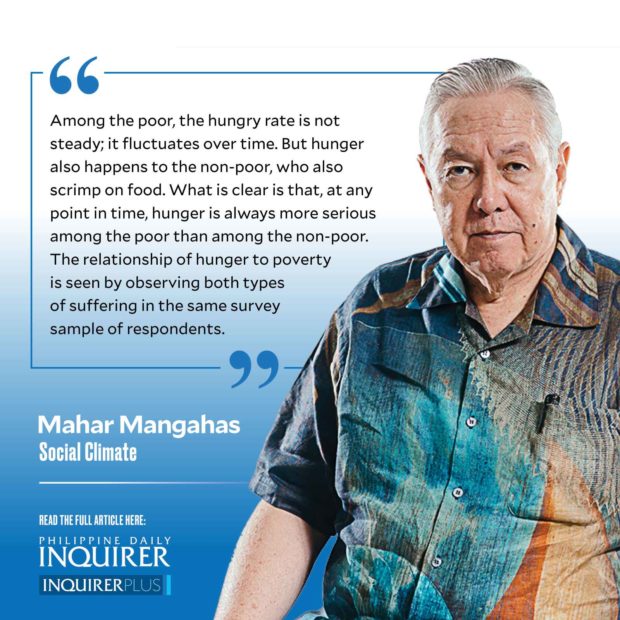The dynamic story of hunger in the Philippines has just been updated by the 96th SWS survey about it since 1998: “First Quarter 2022 Social Weather Survey: Hunger rises from 11.8% to 12.2% of Filipino families,” www.sws.org.ph, 6/6/2022, from which all numbers given in this column can be read off directly.
The title of the new report refers to the single-quarter change from 2021Q4 to 2022Q1. The new 12.2 percent hunger rate, applied to the national total of 25.5 million families (official estimate), implies 3.1 million hungry families.
The survey has two degrees of hunger: “Severe” means hungry often or always in the past three months; “Moderate” means hungry once or a few times in that period. In 2022Q1, Severe hunger is 2.9 percent, estimated 740,000 families; Moderate hunger is 9.3 percent, estimated 2.4 million families.
For the hunger topic, the SWS unit of observation is the family, for which the official projected numbers are now 25.5 million in the Philippines (PH), 3.4 million in the National Capital Region (NCR), 11.5 million in Balance Luzon (BL), 4.8 million in the Visayas (Vis), and 5.8 million in Mindanao (Min). A single point is roughly 250,000 families; 4 points means 1 million, so 12 points means 3 million.
The national hunger rate is worse now than when first surveyed by SWS 24 years ago, at 8.9 percent, which we considered so serious as to warrant quarterly surveying from then on. There are no counterpart official quarterly numbers for hunger; indeed, the government does not even measure hunger annually.
Despite having the least poverty, NCR has the most hunger. The quarterly Social Weather Survey is designed to estimate PH by combining separate estimates for NCR, BL, Vis, and Min. The percentages hungry in the last two quarters were:
2022Q1: PH 12.2, NCR 18.6, BL 11.7, Vis 7.8, Min 13.1.
2021Q4: PH 11.8, NCR 22.8. BL 9.2, Vis 9.7, Min 12.2.
This shows NCR as the worst-off in both quarters. Urban families are obviously handicapped in terms of land on which to grow/raise some food at home—SWS has begun to collect data on this, and will report it next time.
Hunger subsided in NCR and Vis; it worsened in BL and Min. The net result was a slight worsening in PH in the most recent quarter. Note that the error margins for these numbers are plus/minus 2.6 percentage points for PH, and 5.2 points for each survey-area; the latest single-quarter changes are too small to be statistically significant.
Hunger has partially recovered. How does present hunger compare with the entire year 2021, the entire year 2020, and the entire (pre-pandemic) year 2019? The hunger percentages for the past three years (four-quarter averages) are:
2021 average: PH 13.1, NCR 16.4, BL 12.6, Vis 10.1, Min 14.6.
2020 average: PH 21.1, NCR 22.2, BL 17.2, Vis 24.2, Min 25.5.
2019 average: PH 9.3, NCR 11.3, BL 8.5, Vis 9.2, Min 9.9.
This shows how catastrophic 2020 was in terms of hunger. Hunger has generally fallen since, but not yet recovered to pre-pandemic 2019, when it was single-digit in three of the four areas.
NCR also had the worst hunger in 2021 and 2019. In catastrophic 2020, it was worst in Mindanao, but was also above 20 percent in Visayas and NCR.
Hunger and poverty move differently. Whereas the poverty long-term trend is erratically downward (see my “Watch poverty, not economic growth,” 5/21/22), the hunger trend is different. After being mostly single-digit in 1998-2003, it relentlessly worsened in 2004-12, reaching nearly 20 percent. It slowly recovered in 2013-19, until the pandemic struck, and it hit 30 percent in mid-2020.
Among the poor, the hungry rate is not steady; it fluctuates over time. But hunger also happens to the non-poor, who also scrimp on food. What is clear is that, at any point in time, hunger is always more serious among the poor than among the non-poor. The relationship of hunger to poverty is seen by observing both types of suffering in the same survey sample of respondents.
Over time, changes in hunger (like changes in poverty) are strongly related to cost-of-living inflation, and weakly, if at all, related to the gross domestic product. The scientific way to establish its determinants is to build statistical models about it—as national statistician Dennis Mapa used to do, when he was dean of the UP School of Statistics. The first requisite in building such models is a serye of data about hunger.
——————
Contact: mahar.mangahas@sws.org.ph


